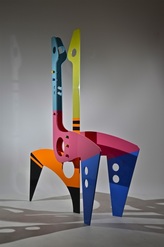| Sam Shedi MRBS Surrey University, Guildford Wednesday 4th November 2015 http://www.samshendi.co.uk Sam opened the lecture by posing the question: "What is sculpture?" Frank Stella said: "A sculpture is just a painting cut out and stood up somewhere." Sam's life has been a quest to find out the answer to that question. |
It has not been an easy journey and the ever present pressure to make money to fund his quest is clearly a challenge for him. He is also very aware of time, the fact that he is getting older.
"Maybe when I am dead I will make money from my sculpture, or my children at least will."
Sam explained how he got interested in art as a subject. For him it was “an easy way to get out of education”. He studied classical sculpture for 4 years and suggested that “to break the rules you first have to learn the rules”.
Sam says has never been interested in going to art galleries or being part of the art world.
He spent all his money on making his sculptures. He worked out early on that he’d have to make money on other things to make his sculptures. Self-funding his quest to explore sculpture.
The Egyptians view was that “Sculpture was just for Gods”. That sculpture was “The soul of culture”. Sam loves the fact that sculpture stays. It lasts. Paintings may turn to dust, but strong physical sculpture lasts and lasts. It has a kind of permanence.
The Romans introduced emotion into sculpture and the idea of body language to express emotions.
Sam’s current view is that of one of his teachers. That
“Sculpture is a vessel for the ideas of the sculptor”.
Sam is above all a figurative artist. It is the human that intrigues him. When he started working in sculpture Henry Moore & Michelangelo were a big influence and he was very conscious that he could: “Never be better than Moore or Michelangelo”.
He likes the idea of “making a memory of a person that lives forever”.
He feels that the world is a complicated place, too complicated, and that we need sculpture to simplify our understanding of the world.
Regarding his sculptural language: He does not believe in rules. He likes the idea of purposeful creation. There must be meaning in the work, and he likes to “put every emotion into the vessel”. He wants his sculpture to “touch you in a meaningful way”. He uses colour to express the emotion of the subject. All colours are very carefully selected and rendered onto the work.
He does not follow the contemporary art scene as it stops him from making his own work. Time seems very precious to Sam.
In 2013 he won the Royal British Society of Sculptors award.
Sam gave us a tour of his work with slides.
“The bow”.
“Mother and child”.
“The wedding dress”
“Evolution”
The work made with pipes was inspired after a project to build an exhaust for his motorbike. He asked the exhaust making company if they could make pipes in any shape. They said “of course”. And so began a relationship where he spent a lot of money making pipe sculptures with them!
He says all his work is simply fed from being aware of his surroundings:
“It’s enough to open my eyes every day”
He wants his work to reflect the time we live in. He described how one piece was inspired by a mother and child in the playground, the child wearing a Spiderman costume. The blue and the red colours of the child in the work are that Spiderman costume.
He said he wants people to touch his work. (But not to climb on it. LOLs.)
Sam said “He could be a God by creating his own vessels”. That he explores “The beauty in our sorrows”. “A sculptor is a creator, God-like”. He enjoys the creation and freedom to create anything.
So: “Sculptor” = “Creator”.
If we look into the metal folds of some of his work we see faces, but he has not put them there. He explores the idea that we see what we want to see, and it often takes human form.
Sam was the only boy in the family. He has 8 sisters so he feels a special empathy with women. His work “expresses the female”. He’s a people person...“It’s all figurative”.
“Sculpture should capture something important that needs to be remembered.”
He says that life can be seen like a video rolling, where every frame is a potential sculpture.
Sam said he makes sculpture every day and it takes 2-3 weeks to finish a piece. He wishes to create work that touches someone else. Moreover he wants to appeal to the general public. He does not want to speak to a minority group. He wants his work to be remembered by many people.
“The general public is what counts, you’ll be forgotten otherwise”.
All his work is inspired by nature, the living. Sculpture is free and you have to believe in your work. “It’s not about how confident you are, you do have to have some doubt. The work must have some meaning to you. In the end the work is about YOU and YOU ONLY and you have to be doing it for the right reason”. That reason, for Sam, can’t just be for the LOVE of it. “Without a reason the vessel is empty”. Also your motivation has to be true. It cannot be about selling. It is difficult to sell work and if you make work with the intent of selling it’s not the right reason. You need to clear your head of “material” thoughts, “doing work to sell means the end”.
On the subject of making money he says it is tempting to become a professor. But if you do that you may not make art yourself! You need to express things in YOUR life and remember the moment of inspiration. He has funded his own work through his pencil... doing design work, for example for video games companies.
Sam sees his sculptures as his babies and finds it very hard to part with them, even for a high price. He loves to have them around him. Even if they are covered up, they are still “there”. He feels that making art is the strongest gift man can have.
He talked about his recent work as a painter. The transition from sculptor to painter is a rare one. Usually it’s the other way around as in his view sculpture is the destination and once there it is hard to “go back” to painting. But he is exploring painting and they are works informed by his sculpture.
Interestingly, with his sculpture, he never works from nude models. He puts this down to the country in which he was born and raised [Egypt] where nude models were not allowed. So he always had to do without models and look to the people around him and in his life.
He said that true art is driven by emotions. That his sculptures are never really finished [to perfection] and in that sense he is a “Try-er” not a “Sculptor”.
The best advice he can give is to do more drawing and practice. “It’s all about the drawing”. He has many notebooks with ideas which he draws and explores. He has many many ideas. The important ones “stick” and usually result in a sculpture. He sketches every day and says “You should draw as much as possible.” When he is ready to make a sculpture, he sees it in his head fully formed, perhaps without the colours, but the work is completed in his head before he starts it. Sometimes it takes a long time between conception and build. So for example he conceived one sculpture in 2001 but did not make it until 2008 due to funds.
He likes to go and visit the sculptures that he has sold to collectors. “I made them, they are my babies”.
He said that sculpture cannot be stored away, stacked, like paintings, you HAVE to [are forced to] live with them.
More recently he is moving back to carving work rather than making it with pipes etc. He suggests using the most basic of materials for this process. For example he currently uses a lot of gaffer tape and other builders materials, like roof resin, which he buys in large tins. Simple cheap materials.
In conclusion, Sam was a very genial and generous man and it was a pleasure and a privilege to hear him talk about his work and life experiences so openly. I resonated with much of what he had to say, especially his emphasis on drawing.


 RSS Feed
RSS Feed